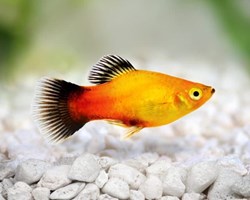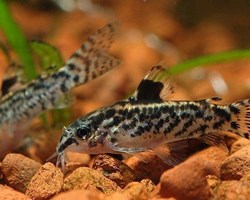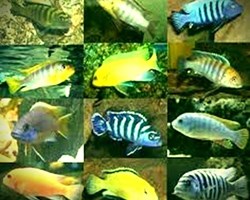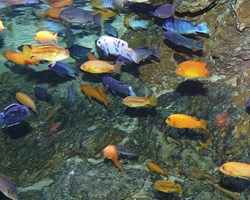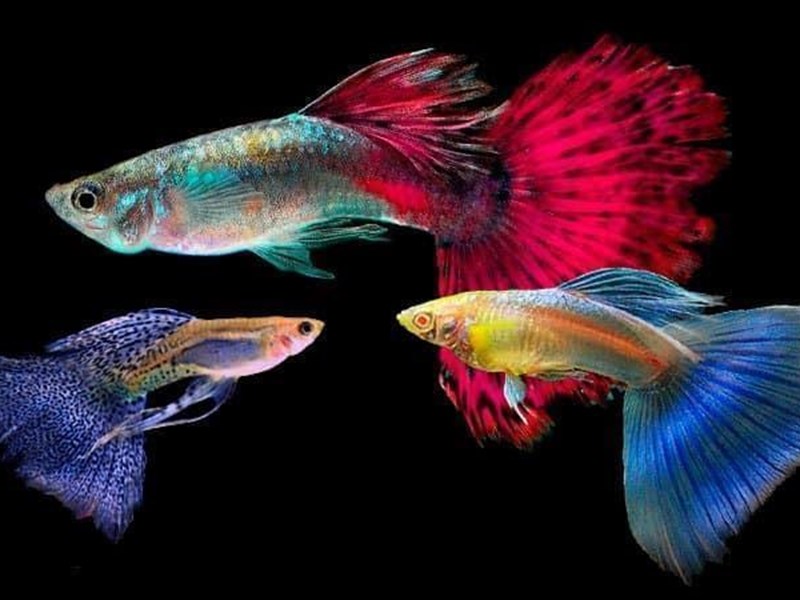
DESCRIPTION OF THE GUPPY FISH:
The Guppy Fish belongs to the Poeciliidae family, which in turn falls within the Cyprinodontiformes group.
Among the freshwater aquarium fish they are probably the most popular, there are four basic reasons for their popularity:
- They are very easy to care for fish, suitable for the most novice acuriophiles.
- They have an attractive color palette, and a very striking and distinctive tail fin, which can vary from one specimen to another, but which always attracts attention due to its enormous beauty.
- They are very resistant, they are able to withstand the most typical mistakes of novices.
- They reproduce easily. Being able to reproduce fish inside the aquarium is always a great satisfaction.
There is a curiosity about these fish and their discovery, as with other species of animals and plants, was "discovered" in different places, by different people who gave them different names.
Its scientific name (Poecilia reticulata) is due to its true discoverer, the zoologist Wilhelm Peters in 1859.
But its commercial name "Guppy", we owe to the naturalist John Lechmere Guppy.
Guppy's name is remembered because he did a great job with this fish, eradicating malaria.
But they are not the only names it bears, since in Trinidad it is known as "million fish" because of the ease with which it reproduces.
In Argentina and Uruguay it is known as “lebistes”.
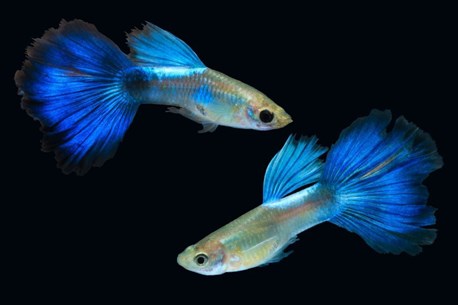
Guppies have an obvious and marked sexual dimorphism, so it is easy to distinguish male Guppies from female Guppies.
Males are smaller compared to females, between 3 to 4 centimeters and have a greater variety of colors.
Another differentiating characteristic is that they have a modification of the anal fin called gonopodium, which is their sexual organ, located on the back of the fish and has a shape similar to a stick.
The caudal fin of the male Guppy Fish is surprising for the large number of shapes it can have.
Due to the crossbreeding and genetic modifications to which it has been subjected over time, we can find male Guypps with pointed, rounded, crown-shaped, delta-shaped, double-sword-shaped fins and the most common and appreciated, the tail fin fan-shaped.
In the Guppy fish, the females are larger, between 6 and 8 centimeters, bulky and opaque in color.
In the species bred in captivity and selected for the aquarium, the caudal fin has a more intense coloration.
THE TYPES OF GUPPIES:
Due to the high demand for Guppy fish, large aquarium fish producers are constantly looking for an amazing new variety that will appeal to aquarists.
Among the most demanded Guppy fish, some varieties of Guppy have been with us for a long time, while others are of recent creation.
- Shovel-tailed guppies.
- Superior Swordtail Guppy.
- Lower Swordtail Guppy.
- Double sword-tailed guppy.
- Lyre tailed guppy.
- Round tail guppies.
- Needle-tailed guppies.
- Spiky tailed guppy.
- Guppies triangle tail.
- Fan-tailed guppies.
- Flag tailed guppy.
- Veil tailed guppy.
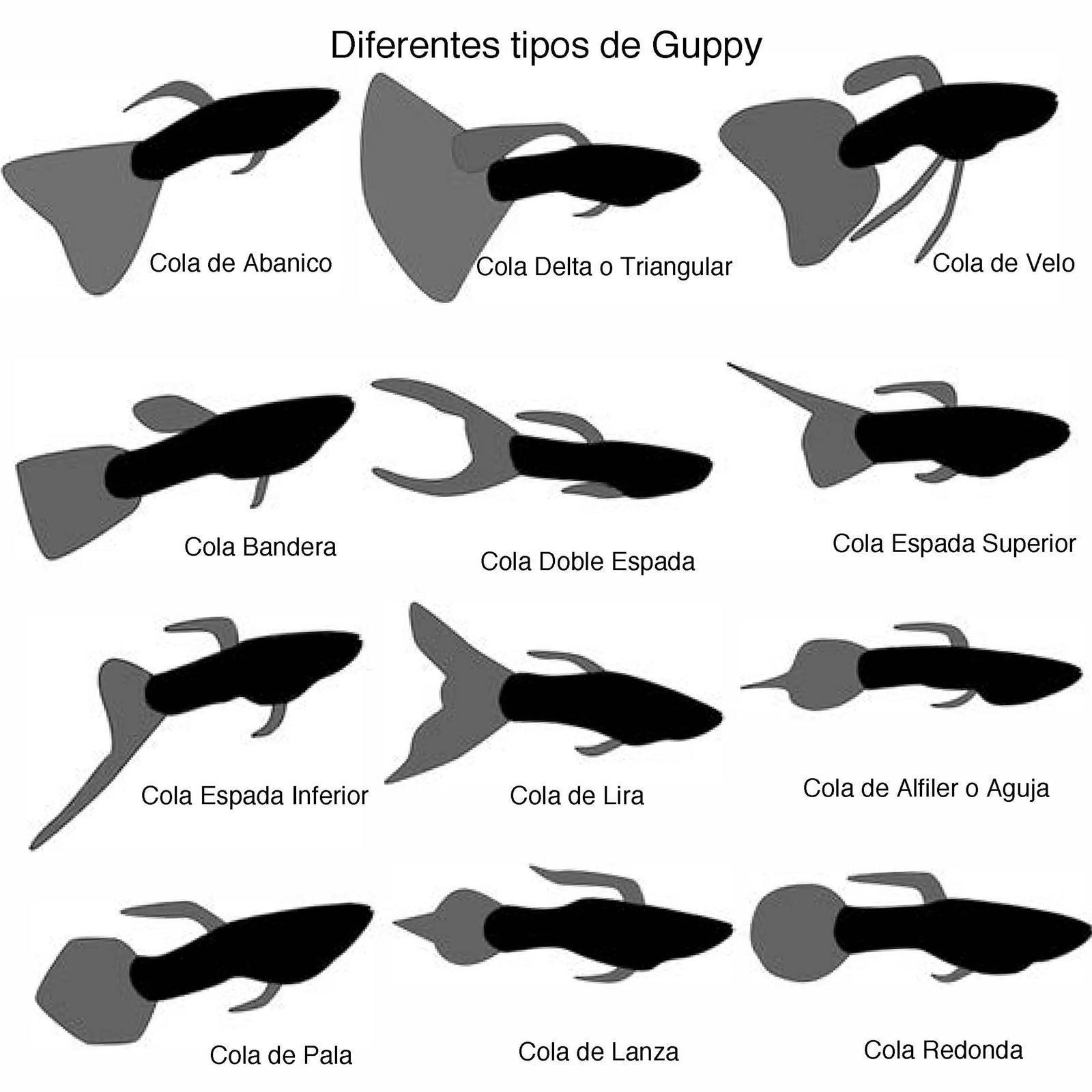
In addition to the above, which we could say are the traditional Guppies, there are other Guppy fish that we at Glu Glu Pet would like to highlight, either because they are considered a different endler variety, or because of their original leopard coloration, or because we may be to a new crown tail mutation.
GUPPY ENDLER:
The Guppy endler or Poecilia Wingei. It has bright metallic colors, which may be due to its original habitat.
They have a multicolored coloration, with gray, gold or silver tones, which makes them very striking and desired in aquariums.
In terms of size, they are quite similar to normal Guppies.
Its tail fin is transparent, and quite normal compared to most commercial Guppies.
Its appeal lies in its metallic color.
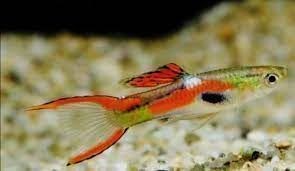
LEOPARD GUPPIES:
Leopard Guppies stand out for the coloration of their caudal fin.
The true leopard guppy is yellow, but there are colors that are just as showy, such as the male leopard guppy rose gold, semi black, mosaic green, diamond blue, yellow cobra... and a good number of equally striking colors.
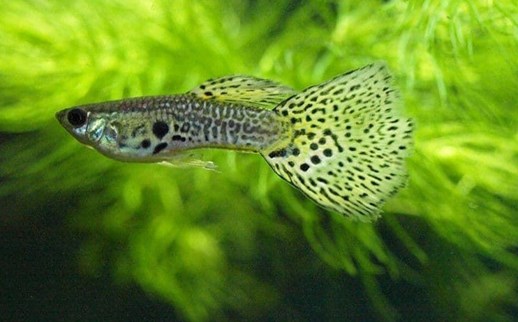
GUPPY CROWNTAIL:
It is a question of a variety of recent appearance, they are the Guppy tail of crown.
To get this new variety, it has been sought to generate mutations in its fins.
It is not yet a species admitted to exhibitions, because no guidelines have been established to guide it.
Within these Guppies, there are three subgenera:
- Swallowtail: swallowtail.
- Combtail: with tail similar to the Betta.
- Merah.
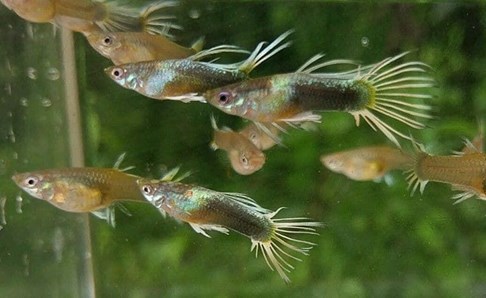
THE DISTRIBUTION AND HABITAT OF GUPPIES:
The Guppy is native to Central America, South America and the southern Caribbean.
It can be found in the wild in Venezuela, Guyana, Suriname, French Guiana, as well as the islands of Trinidad and Tobago, Barbados, Antigua and Barbuda, and the Netherlands Antilles.
In tropical areas it is used to fight against mosquitoes that transmit malaria, since they are great consumers of mosquito larvae.
Although this is its original distribution, the Guppies that we buy in stores are bred in captivity to be sold.
It is a fish highly appreciated by all those who start in fish farming, as it is very robust and easy to reproduce.
It can be found in a large number of places, where it adapts easily: streams, swamps, turbid areas, even brackish waters.
THE BEST CONDITIONS OF THE AQUARIUM:
The size of the aquarium must be in the 80 liters, 45x30x30.
The Guppy fish prefers hard water, although it can live in other more acidic or softer conditions, a good pH is between 7 and 8.5.
The temperature of the water must be between 22º and 28º.
They are fish that like to have at least 12 hours of light a day, and although some breeders think that in a Guppy aquarium it is not necessary to add substrate or place any type of plant, at Glu Glu Pet we believe that it is quite cruel to keep a captive fish as if in a prison, not to mention the need to provide them with shelter and privacy.
Depending on the color of our Guppies, we can place substrates of different colors, to make them more attractive and showy.
As for aquarium plants, they are a component that helps us maintain water quality and the health of our fish.
To maintain good fish health, it is recommended to change 20% of the aquarium water once a week.
From Glu Glu Pet we give you ideas to set up your aquarium:
Complete aquariums:
External filters for aquarium:
Aquarium heater:
- SEA-STAR THERMOHEATER 25W-300W.
- Tetratec HT heater.
- 25-300W Magicterm heaters (PRODAC).
- JAGER THERMOHEATERS 25W-300W(EHEIM).
Aquarium LED Display:
- Tetronic Led Proline 780 screen (TETRA).
- SEA STAR LED AQUARIUM SCREENS.
- 3W white/blue COB LED lamp (ICA).
Sand:
- White diatomaceous sand 5.5L.
- Brown diatomaceous sand 5.5L.
- Black diatomaceous sand 5.5L.
- SILICA GRAVEL.
Substrate for aquarium:
aquarium stones:
Aquarium logs:
Aquarius Quiz:
- JBL TEST CO2 DIRECT.
- JBL TEST GH (Total hardness).
- JBL TEST K (POTASSIUM).
- JBL TEST NH4 (AMMONIUM).
- JBL TEST NO2 (NITRITES).
- JBL TEST NO3 (NITRATES).
- JBL TEST PO4.
- Test GH Prodac.
- Test NO2 Prodac.
- Test NO3 PRODAC.
- Test kh PRODAC.
PH meter:
THE BEST NUTRITION FOR GUPPIES:
Although in the wild they basically feed on insects, especially red mosquito larvae, those raised in captivity admit a wide variety of foods.
Mosquito larvae cannot be missing from their diet, since they provide them with a large amount of protein, necessary for their growth.
The diet should contain daphnia, artemia, which must be supplemented with plant foods in the form of green algae.
In Glu Glu Pet there are many dry foods in the form of flakes, flakes or granules, which are usually very good, because they contain algae, crustaceans and other components that vary depending on the brand and the fish's diet.
A good diet has a direct influence on the coloration of the Guppies, so it is important to keep them healthy and well fed, as well as adding vitamins from group D from time to time.
It is recommended to feed them several times a day because they have a very fast metabolism.
They should be offered small amounts of food, just what they can devour quickly, this way we will avoid that part of this food ends up at the bottom of the aquarium, damaging the quality of the water.
- Tetra Crusta Menu.
- TETRA GUPPIES.
- TETRAMIN.
- AZOO PREMIUM RED LARVA 130ml.
- AZOO PLUS ARTEMIA.
- IT WILL BE VIPAN NATURE.
FOR YOUR BEST CARE YOU MUST KNOW ITS BEHAVIOR AND COMPATIBILITY:
Guppies are calm fish, although they should not be placed next to species that bite their fins, such as the Siamese Fighting Fish, which is very territorial and cannot tolerate fish as active as Guppies.
Among the fish compatible with Guppies, we can mention the Mollyes, the Lemon Tetra and some other characins.
In the aquarium, the male usually harasses the females constantly, to avoid this type of overwhelming situation, it is recommended to have one male for every three females.
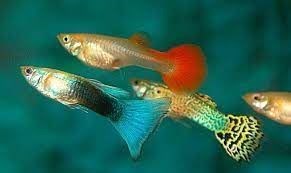
Fish compatible with Guppies:
Fish that are fully compatible with Guppies, because they have similar behavior and similar aquarium parameters, meet three basic requirements:
- They are peaceful fish, they do not have an aggressive character, nor do they have a tendency to nibble the tails of other fish.
- They do not grow much larger than Guppies, preventing them from becoming predators.
- Aquarium conditions, between pH and gH are similar.
- They have a similar size, although it is not always a guarantee of success.
- If they end up outgrowing the Guppies, there will come a time when they cannot share space, such as with Koi Carp or Goldfish.
- Depending on the nature of the fish itself.
- This is difficult to calibrate, but they could share space with fish that are theoretically aggressive, such as a male Betta, as long as the latter's character is not "too" aggressive.
Compatible fish without restrictions:
- Tiger Barb.
- Harlequin.
- Rasbora Galaxy.
- Corydoras.
- drunk.
- Ancistrus.
- Tetra Neon.
- Botia Clown.
- Ax Fish.
- Mollies.
- Bubble eyes.
- Boraras.
- Chinese neon.
- female betta.
- Nun.
- Silver Dollar.
- Kribensis.
- Apple Snail.
- Cherry Barbel.
- Otocinclus.
- Guppy Endler.
Fish compatible with restrictions:
- Ramirezi.
- Angel fish.
- Platy.
- Rainbow.
- Koi carp.
- Goldfish.
- Telescope.
- Disk.
- Wasp.
- Pearl Gourami.
THE REPRODUCTION OF THE GUPPIES:
The Guppy is a fish that reproduces easily.
If you want to breed Guppies in your aquarium, the ideal is to have several females for each male, since they are quite vigorous in their search for females.
The reproduction of the Guppies is of the ovoviviparous type, this means that the female Guppy keeps the eggs inside her, until the time of delivery arrives.
The ritual dance of the male before mating is quite striking.
Once the female is receptive, the male copulates in a fiftieth of a second.
The female is fertilized with the spermatophores, which can be kept inside the female to be fertilized up to five times, without the need for the male to copulate again.
The gestation period will last about five weeks, and can lay between fifty and one hundred and fifty fry.
Guppy female pregnant:
A pregnant female Guppy is recognized when we observe a dark area behind her anal fin, just behind the abdomen.
To have a high success rate, it is recommended to transfer the pregnant Guppy to a breeding tank, where the same water that we have in the tank should be used, so as not to alter the usual conditions.
An environment with many plants and floating vegetation favors the survival of the fry, which are often chased by their mothers to eat them.
In the first stages they should be fed with brine shrimp, crushed scales or powdered food.
At first the fry may seem disappointing, due to their lack of color.
It is not worrying, about three months they are beginning to appreciate their colorful ending, although whether it appears earlier or later will be influenced by the diet and the use of vitamins.
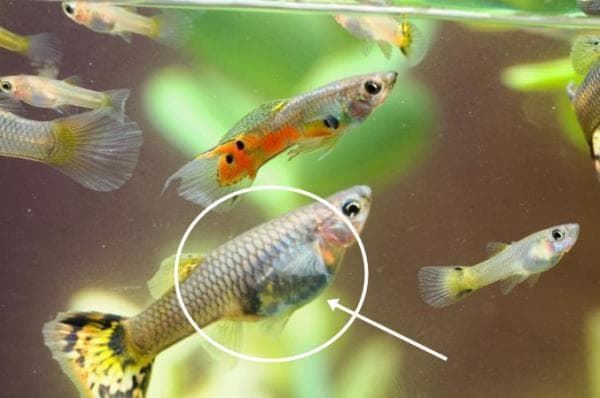
THE BEST CARE OF GUPPY FISH:
This fish is one of the most popular in the world.
There are many varieties available for freshwater aquariums, with a fairly common feature, its elongated fin and garish colors.
One of the problems that we must face when we buy a Guppy is that it may not be as resistant as it may seem at first.
This is due to inbreeding and overproduction of these fish.
Their small size, easy maintenance, and propensity to breed in virtually any environment have made them one of the most ubiquitous and valued freshwater fish.
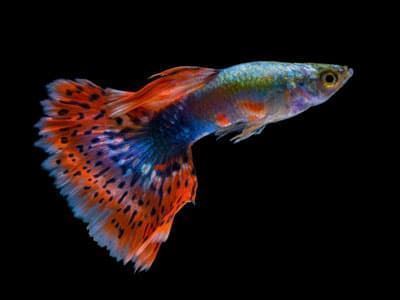
DISEASES OF GUPPIES:
At Glu Glu Pet we think it is important to make it clear that most of the diseases that a Guppy can suffer from are those that are related to poor conditions in the aquarium, when the fish are in captivity.
If you keep your Guppies on the food and aquarium features they need, they should have no major health problems.
Infectious diseases:
This type of health problem is associated with the physicochemical conditions of the water.
There can also be cases in which a Guppy suffers from these common diseases due to its weakened defense systems from birth.
Tuberculosis:
This is a disease that does not occur very often in home aquariums.
When it appears, it is usually the Guppies who suffer from tuberculosis.
This type of tuberculosis is not the same as the one that affects humans, so you should not worry.
Bacteria of the genus Mycobacteria are the ones that cause tuberculosis in fish.
A big problem with this disease is that its symptoms are very ambiguous and not so easy for the caregiver to detect.
The most common problem associated with tuberculosis is the delay in diagnosis.
Due to the time that the infection has to advance in the body of the fish without being detected and the treatments do not usually have good results.
Some of the symptoms that can be found are skin discoloration, lack of appetite or even starvation, retracted fins, bulging or swollen eyes, the belly may also have swelling and discoloration.
The most common route of transmission of these diseases is direct contact between fish.
A contagion can also occur through water, and last and least frequently, it is the transmission of tuberculosis by the embryos while they are still inside the mother's body.
Sepsis:
This is a group of internal diseases of bacterial and/or viral origin.
It produces severe fluid retention, so the first visible symptom is the enlargement of the abdomen.
These diseases are also known as dropsy or ascites.
This disease can also be detected by the increase in the ventral area.
This is caused by bristling of the scales and swelling of the abdomen.
Exophthalmos, hemorrhages and other pathologies at the base of the fins or around the eyes can also be secondary conditions derived from these conditions.
Antibacterials and antibiotics are the main treatments for these diseases.
Concentrates such as chloromycetin are usually used at 10 to 20 mg/l of aquarium water in which the treatment is carried out.
Freshwater white spot:
One of the main diseases that occur in Guppies is freshwater white spot.
This is not a complication unique to Guppies, and not even to fish, it is very common to see it in viviparous.
This infection is caused by the protozoan parasite Ichthyophthirius multifiliis.
White dots on the skin or in the eyes are the most noticeable symptom.
They also appear very frequently on the gills.
Freshwater whitehead treatments are many and varied.
Prophylaxis is one of the most common by raising the temperature between 30°C and 32°C, which decreases the reproduction of the parasite.
Poisonings:
Guppies are not as prone to infections due to the toxic agents that live in the water and decrease the probability of growth of infectious pathologies.
Guppies are the domestic species that presents the most data and infections due to infections.
The presence of nicotine in as little as 10 mg/ can kill small fish in 5 minutes.
An overgrowth of infections can also result from a diet high in commercial and dried foods.
Constant infections can severely weaken the metabolism of fish when they are constantly exposed to these living conditions.
Fatty degeneration of the liver:
A diet based on foods high in lipids can cause this disease.
When carbohydrates are found in high concentrations, it can also be indicative of other problems in the fish's liver.
When there are not enough fatty acids and vitamins, the fat accumulates in the liver, which can cause the liver to stop working and the fish to die.
Obesity is one of the most noticeable symptoms of fatty liver.
This can reach disproportionate levels affecting the anatomy of the fish.
Swelling and exophthalmos usually present in the ventral area.
Treatments for fatty liver in Guppies consist of a change in eating habits.
Lower the consumption levels of lipids and carbohydrates.
Tubifex worms have a high concentration of fat, so their consumption should be reduced.
Health problems associated with water quality:
Staying in slightly acidic waters can cause certain health problems for Guppies.
Tank mates or oxidation of organic matter at the bottom of the tank may cause the pH level to drop, leading to listless behavior and discoloration of the Guppy's skin color.
When the water becomes too acidic for these fish, mucus hypersegregation and jerky swimming can occur.
At this point a water change is necessary to alkalinize the pH to healthy levels for the Guppies.
It is important that this change is gradual because the fish do not usually respond well to a very drastic change in the water.
Carbon salts can be used to harden carbonates that support pH.
When it comes to poor maintenance, the operation of the filter should be checked and the water changed to recover the conditions as soon as possible.
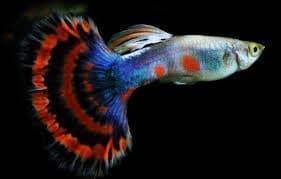
Spinal curvature is one of the most common anatomical defects in Guppies.
The origin can be very varied.
It can be tuberculosis or it can also be physiological anatomical birth defects.
In the case of males, their large fins can curve the vertebrae of the columns.
In the case of females, consecutive births can cause damage to their spine.
The problem with these deformations is that they have no solution, so proportional fish must be chosen and leave a period of rest between the births of the females.

